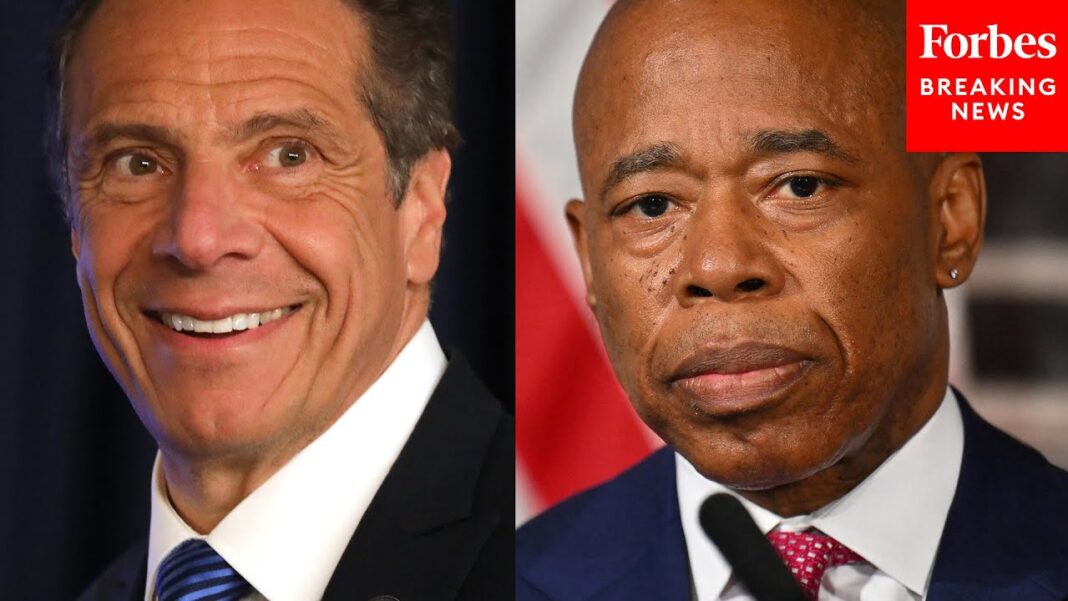|
Getting your Trinity Audio player ready...
|
Cuomo Dominates NYC Mayoral Primary Field as Mamdani Surges Into Second, New Poll Shows
Edited by: TJVNews.com
In a striking show of political resilience, former Governor Andrew Cuomo has surged to the forefront of the Democratic primary field in the race for New York City mayor, commanding a 38% share of Democratic support in the latest Emerson College/Pix11/The Hill poll released Wednesday. According to a report in The New York Post, Cuomo’s lead is not only commanding—it’s expanding.
Meanwhile, a political outsider with hard-left credentials is making waves. Democratic Socialist Assemblyman Zohran Mamdani, who had barely registered in earlier polls, has vaulted into second place with 10% support, leapfrogging several seasoned citywide officeholders and becoming Cuomo’s closest challenger—though still a distant one.
The poll indicates that Cuomo’s support has climbed five points since Emerson’s previous survey in early February, which was conducted before his official campaign launch on March 1. At that time, he stood at 33%, already leading, but the new numbers solidify his place as the frontrunner in a crowded and fractured Democratic field.
“It’s Cuomo’s race to lose,” said Spencer Kimball, executive director of Emerson College Polling, in comments published by The New York Post. “With about three months until the Democratic Primary, Governor Cuomo has emerged as the top candidate in the race, with no clear alternative emerging among Democratic voters,” Kimball added.
The real surprise in the numbers is the rapid rise of Zohran Mamdani, an Assembly member from Queens affiliated with the Democratic Socialists of America (DSA). The New York Post reported that In Emerson’s February poll, Mamdani was at a mere 1%, but he has since rocketed to 10%, surpassing high-profile city officials like Mayor Eric Adams (8%), Comptroller Brad Lander (6%), and State Senator Jessica Ramos (6%).
A separate poll released by Data for Progress, a progressive think tank, confirmed Mamdani’s rising support, showing him at 15%, again in second place behind Cuomo. Though far from catching the former governor, Mamdani has emerged as the candidate of choice for the party’s energized progressive wing, especially among younger voters.
Both Mamdani and Ramos performed best with voters under 30, garnering 16% apiece in that demographic, while Cuomo’s support skews heavily older, peaking at 44% among voters over 70.
The rest of the field remains in the single digits, with former Comptroller Scott Stringer at 5%, Council Speaker Adrienne Adams and State Senator Zellnor Myrie at 4% each, and former Assemblyman Michael Blake and financier Whitney Tilson trailing far behind at 1% and 2%, respectively, The New York Post report said.
One of the most telling findings is that 18% of Democratic voters remain undecided or support a candidate not listed, a clear indication that the race still has room for surprises—but also underscoring the challenge for any one candidate to consolidate an anti-Cuomo bloc.
Even with the city’s ranked choice voting (RCV) system, Cuomo appears well-positioned. The survey shows he is the second-choice candidate for 10% of voters, potentially helping him maintain a lead through multiple rounds of vote tabulations.
Cuomo’s strength lies in his enduring appeal among older and minority voters, according to the report in The New York Post. He garners 47% of Black voter support and 45% of Hispanic voter support, numbers that far exceed any of his competitors. His support also increases with age: from 21% among voters under 30 to 44% among those over 70.
These demographics are critical in New York City Democratic primaries, where turnout tends to skew older and more diverse—advantaging candidates like Cuomo with deep ties to established political machines and name recognition.
The poll also explored a hypothetical general election scenario in which Mayor Eric Adams runs as an independent against Cuomo, Republican nominee Curtis Sliwa, and independent candidate Jim Walden. The results showed Cuomo leading with 43%, Sliwa with 13%, Adams pulling 11%, and Walden at 4%.
The numbers shed light on Cuomo’s broad electability, even in a fractured general election race, and reflect his ability to draw support across multiple constituencies—even while facing continued criticism over his resignation and the scandals that prompted it.
Meanwhile, Mayor Eric Adams, who is running for reelection amid persistent criticism over public safety and his handling of the migrant crisis, has seen his support drop from 10% to 8%, as was reported by The New York Post. His standing has weakened as progressive challengers like Mamdani gain steam and centrists rally behind Cuomo.
Former City Comptroller Scott Stringer also lost ground, slipping from 8% to 5%. Adrienne Adams, the current City Council Speaker who recently entered the race, polled at 4%, marking her first appearance in an Emerson survey.
The remaining field is fractured: Comptroller Brad Lander and State Senator Jessica Ramos remain at 6% apiece, while Council Speaker Adrienne Adams, State Senator Zellnor Myrie (4%), financier Whitney Tilson (2%), and former Assemblyman Michael Blake (1%) round out the field. Notably, 18% of respondents are undecided or support someone else, leaving room for late-breaking momentum or potential shifts in the coming months.
One of the poll’s most revealing findings, as reported by The New York Post, is the overwhelming desire among Democrats for a mayor who will actively challenge Donald Trump and his agenda. A commanding 63% of Democratic voters said they want the next mayor to “stand up to President Trump”, while only 28% preferred that the next mayor simply “work with the White House.” Another 9% remain undecided.
This signals that the Democratic primary electorate is seeking a combative figurehead—someone who won’t merely manage the city, but also serve as a national political counterweight to the former president, who is currently the GOP’s frontrunner for the 2024 presidential election.
When asked about their top issue in the mayoral race, 33% of voters pointed to public safety and crime—a clear indication that concerns about rising incidents, especially in the subway system, remain top-of-mind.
That was followed by 23% who cited housing, as the city continues to grapple with skyrocketing rents and limited affordable options. The New York Post report said that the migrant crisis was named as the top issue by 10%, with other priorities including healthcare (7%), homelessness (6%), jobs (5%), and education (4%).
The economic strain on everyday New Yorkers also came into sharp focus: 35% cited the cost of housing as their biggest financial challenge, 29% pointed to the price of groceries, and 5% mentioned taxes.
When asked whether New York should remain a “sanctuary city”, nearly half of Democratic voters (46%) said yes, while 34% want local laws repealed. Another 19% are undecided. This reflects the political tension surrounding immigration, particularly with the influx of migrants that has strained city services and budgets, as observed in The New York Post report.
On the subject of public transit, nearly half of voters (48%) said the subway is becoming less safe, compared to just 20% who believe it’s improving. One-third believe conditions have stayed about the same.
These concerns about crime and safety may be a key vulnerability for Mayor Eric Adams, whose administration has heavily emphasized policing and public order but has yet to convince large segments of the electorate that conditions are materially improving.
The debate over congestion pricing—a policy set to charge vehicles entering Manhattan’s central business district—has also split public opinion. The New York Post report said that according to the Emerson poll, 44% of voters oppose the policy, while 42% support it, with 14% undecided.
Interestingly, the divide follows racial lines: 51% of white voters support congestion pricing, but 53% of Black voters and 52% of Asian voters oppose it, according to Emerson’s Spencer Kimball.
This reflects broader questions of transportation equity and the socioeconomic impact of congestion pricing on outer-borough commuters.
The Democratic primary is scheduled for June 24, with a week of early voting beforehand, leaving roughly three months for candidates to gain traction. With Cuomo drawing nearly 40% of the vote and Mamdani the only other contender in double digits, the field faces mounting pressure to consolidate or shift the narrative, The New York Post report said.





Mamdani in second place. That’s a shundah and says too much about NYC’s one million mozIems and over two million bIacx. Look at the NYC Council, yikes!